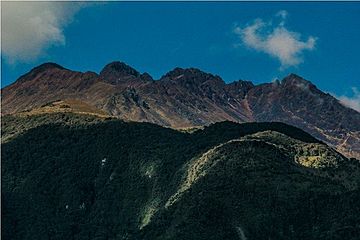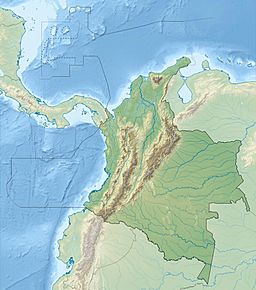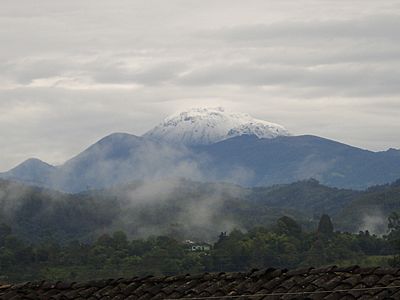Sotará (volcano) facts for kids
Quick facts for kids Sotará |
|
|---|---|

Sotará in 2016
|
|
| Highest point | |
| Elevation | 4,580 m (15,030 ft) |
| Listing | Volcanoes of Colombia |
| Geography | |
| Location | Sotará, Cauca |
| Parent range | Central Ranges, Andes |
| Geology | |
| Mountain type | Extinct basaltic-andesitic stratovolcano |
| Volcanic belt | North Volcanic Zone Andean Volcanic Belt |
| Last eruption | unknown |
Sotará is a large, cone-shaped volcano. It is located in the Cauca Department of Colombia. This volcano is known for its hot springs and gas vents. Sotará is considered an extinct volcano. This means it is not expected to erupt again.
What is Sotará Volcano?
Sotará is a type of volcano called a stratovolcano. Stratovolcanoes are tall and cone-shaped. They are built up over time by many layers of hardened lava, ash, and rocks. Sotará is made mostly of basaltic and andesitic rocks.
This volcano stands tall in the Central Ranges. These ranges are part of the larger Andes mountain chain. Sotará reaches an elevation of 4,580 meters (about 15,026 feet).
Hot Springs and Gas Vents
Even though Sotará is an extinct volcano, it still shows some activity. It has hot springs that are very warm. The water in these springs can reach temperatures of 80 degrees Celsius (176 degrees Fahrenheit).
The volcano also has fumaroles. Fumaroles are vents that release gases from inside the Earth. The gases coming out of Sotará's fumaroles are mostly carbon dioxide (CO2). About 80% of the gas is CO2. The other 20% is hydrogen sulfide (H2S).
Location and Geology
Sotará volcano is found in a special geological area. It sits between two large cracks in the Earth's crust. These cracks are called faults. To the west of the volcano is the Silvia-Pijao Fault. To the east is the San Jerónimo Fault. These faults are important features of the Earth's geology in this region.
Gallery
See also
 In Spanish: Volcán Sotará para niños
In Spanish: Volcán Sotará para niños
- Geology of Colombia
- List of volcanoes in Colombia
- List of volcanoes by elevation



